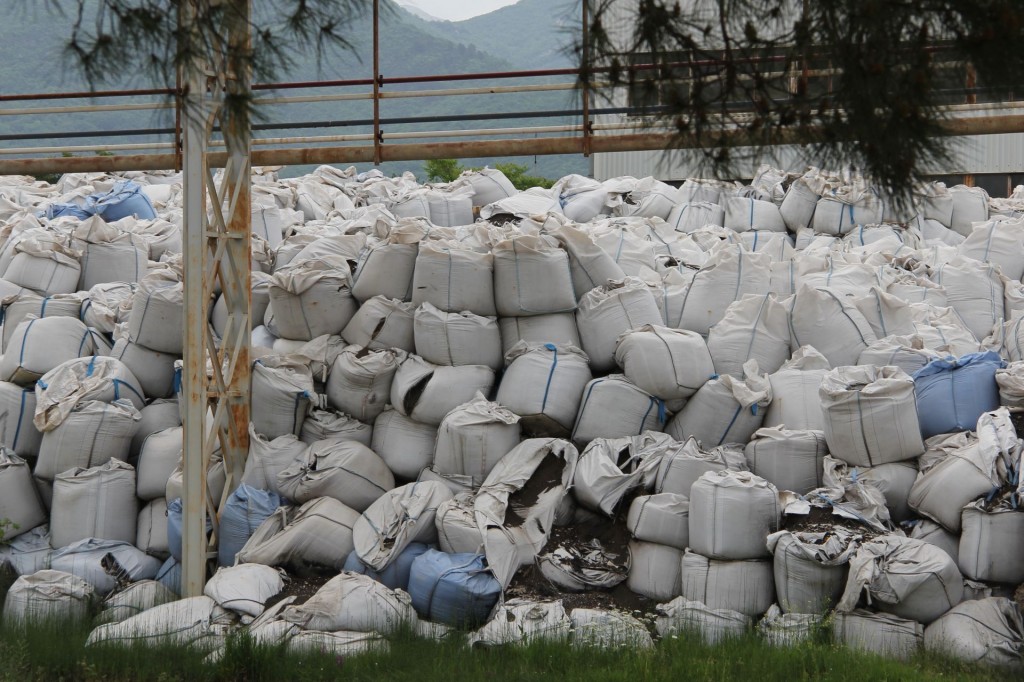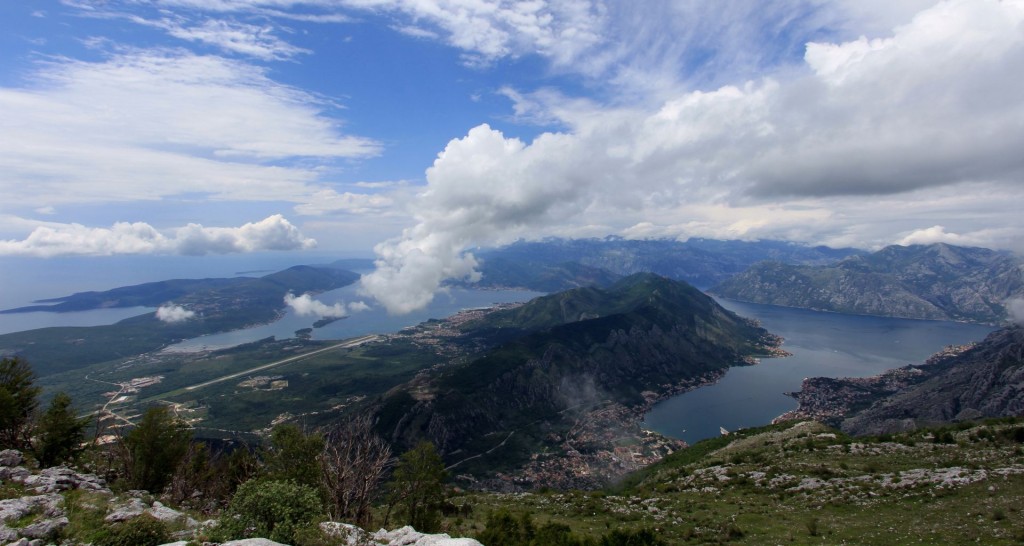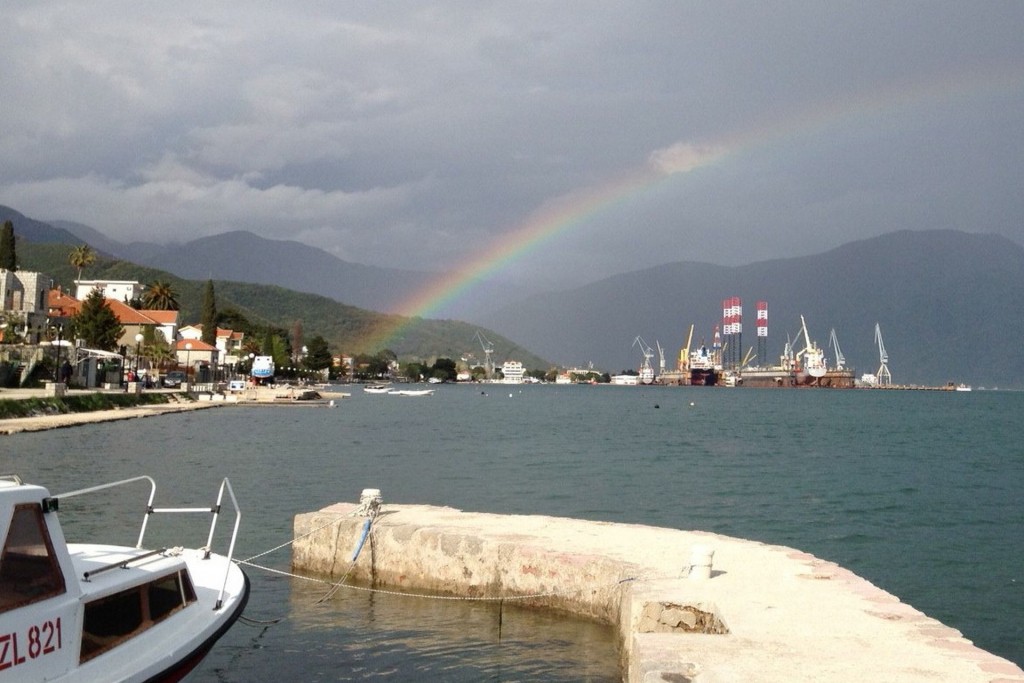 My small studio in Bijela is an oasis of peace in the summer months, when more famous tourist resorts are overcrowded, hot and dirty. The sea is clean, we have a great view of Mt Lovćen and many nice beaches in Boka are accessible when you have a boat: not only around Tivat and its beautiful islands, but also along the coast of the Luštica peninsula.
My small studio in Bijela is an oasis of peace in the summer months, when more famous tourist resorts are overcrowded, hot and dirty. The sea is clean, we have a great view of Mt Lovćen and many nice beaches in Boka are accessible when you have a boat: not only around Tivat and its beautiful islands, but also along the coast of the Luštica peninsula.
But there is a problem that is causing more and more commotion among the permanent and temporary inhabitants of Bijela. It consists of 27,000 m3 of grit, a dangerous and toxical waste material produced by the Shipyard in Bijela, which is packed in 30,000 jumbo bags stored behind the shipyard building close to the road. Since 2010, many news articles have been written, contracts were concluded, papers were signed, but nobody knows when this poisonous waste will be exported, as it was promised several years ago.
 Peter Munk, the owner of the exclusive company Porto Montenegro – who has promised to create 1,000 new jobs in 2013 – is ready to establish a partnership with the shipyard and to create a company for yacht repair, but everything depends on the removal of the present grit.
Peter Munk, the owner of the exclusive company Porto Montenegro – who has promised to create 1,000 new jobs in 2013 – is ready to establish a partnership with the shipyard and to create a company for yacht repair, but everything depends on the removal of the present grit.
I wondered how dangerous this material is, when I saw that many of the bags are damaged and the grit is now exposed to rain and wind. Is it poisoning the ground, the water or the air? Is it dangerous for the inhabitants and tourists staying in Bijela?
After having attended the interesting Conference on the Utilization of New Technologies for Environmental Monitoring in Cetinje yesterday, I decided to become more active in reporting all environmental black spots, illegal dumping grounds and other irregularities I see when traveling through Montenegro.
 So I put a picture of the damaged bags on Facebook and got an immediate response from Aleksandar Perović (Ecological Movement OZON), who contacted the main ecological inspector, Vesna Zarubica. It was interesting to hear that “the export of grit depends on the agreement with the World Bank” (which, of course, means MONEY!). Aleksandar was also informed that the damaged bags will be replaced “when the time comes to transport them”.
So I put a picture of the damaged bags on Facebook and got an immediate response from Aleksandar Perović (Ecological Movement OZON), who contacted the main ecological inspector, Vesna Zarubica. It was interesting to hear that “the export of grit depends on the agreement with the World Bank” (which, of course, means MONEY!). Aleksandar was also informed that the damaged bags will be replaced “when the time comes to transport them”.
Aleksandar, thank you for your help and information! I really hope that this “Ecological Black Spot” in Bijela will be removed as soon as possible, as we cannot develop tourism in the beautiful Boka Kotorska with such dangerous and toxical waste material on the banks of the Bay!


Dear Marianne / Mariana
I fell in love with Montenegro when I first visited the country for a day trip, from Dubrovnik, in the October following Montenegro’s independence. I have since been back on 5 trips.
Your post about the problem in Bijela struck a chord with me. I would not have known about this problem had it not been for your post, but I have begun to worry with each passing year about the increase in what might be termed general, day to day, environmental problems. For example, I see increasing amounts of litter in the Bay of Kotor and in rivers in the north of the country, in particular in Kolasin. I last visited Kolasin in December 2012. The river running through it was despoiled with large amounts of litter, such as plastic bottles, plastic bags and paper rubbish, caught in its bends and where buildings or the old mill protruded into the river.
Both parts of Montenegro are stunning, as is the majority of the country. I believe that it is the setting and the environment which attract so many to Montenegro each year. For visitor and inhabitant alike, this increase in general pollution will exact a toll – on health, on the attractiveness of the country and on Montenegro being viewed as an ecologically pristine country.
I will still visit – I am bringing friends with me this Summer to stay in Prcanj and enjoy the delights and beauty of the Bay and its towns, villages, Kotor itself and its environs. I also hope to spend a few days in the North. But the increase in litter and signs of pollution in the Bay, in some rivers and by the roadsides has taken some of the shine off Montenegro’s natural beauty which, along with its hospitable people, is one of, if not the number one reason why it is regarded as jewel of the Adriatic.
Dear Susan,
Thank you for your comment. I completely agree with your observations! Fortunately, many young people in Montenegro are trying to resolve the litter problem and I am sure that the situation will improve in the near future.
I wish you all the best and I hope that you will bring many friends to this beautiful country!
Dear Marianne,
We were yesterday in Bijela Shipyard (22-1-2104) to look at this problem of BigBags with used grid. I work for a Recycling company in Holland and were invited by the people of Porto Montenegro to come with possible solutions for this waste disaster. I have never seen such neglected working area. This environmental problem is not good for the people of Bijela but also for the complete ecologic area! We have a very good solution to solve this problem but the people of the Beijla shipyard keep telling us that the complete volume must be shipped away. We can tell you that no country is allowed to receive such a volume of polluted grid which is marked as hazourdes waste. The wish of shipping away the complete volume is coming from the Environmental Agency of the area of Beijla /Tivat. Can you help us to make contact with the responsible people of this Agency? We want to explain our solution to them and we know that our solution is cheaper than calculated by the World Bank and we can solve it within 1 year.
Dear Koes,
Thank you for your mail. This is a very interesting case indeed! Since the publication of my blogpost, several articles have been published in the Montenegrin newspapers about this issue, but nothing happened. I have forwarded your letter to my son-in-law, Slaven Radunovic, (opposition) member of Montenegrin Parliament and President of the Parliamentary Council for European Integration. Last year he asked a question in Parliament about this “black spot”, but he never got a satisfactory answer from the ministry. He conveyed your message to Ms. Olivera Brajovic, director for tourism development and standards in the Ministry of Sustainable Development and Tourism. I am sure that you will soon be contacted by the responsible people and that you will have the opportunity to explain your solution. Much success and all the best!
Marianne
Dear Marianne,
Thank you for your reply! I thank you if you wil ask Mr.Slaven Radunovic or Ms. Olivera Brajovic to contact via Email: koes@rcn.nu or just call me on my mobile 0031 64 67 67 566 or office 0031 182 616 826.
Best Regards
Koes de Quillettes